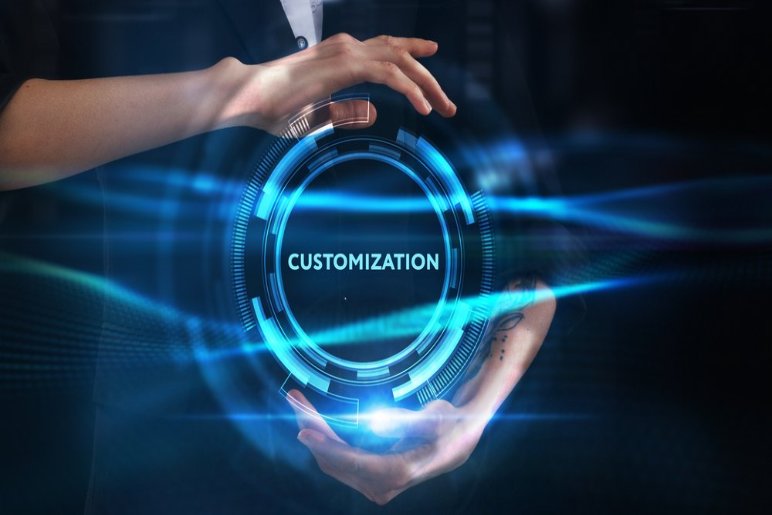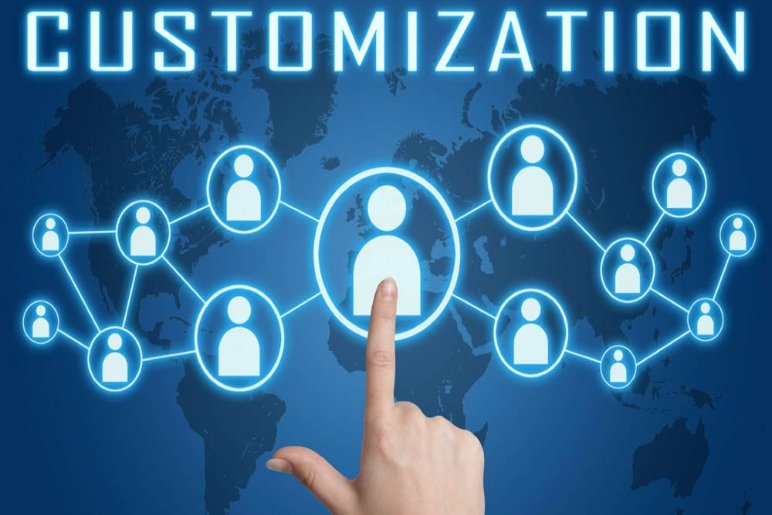In today’s world, where mass production and standardization reign supreme, customization has emerged as a powerful antidote. It’s the art of tailoring products, services, or experiences to meet the unique needs, preferences, and desires of individuals. From personalized clothing to custom-built cars, customization has become a driving force in various industries, revolutionizing the way we interact with brands and products.
Customization of online ads and streaming services

Online advertising and streaming services have become increasingly tailored to individual preferences, enhancing user experience and driving engagement. Through advanced data analytics, algorithms can track user behavior, preferences, and demographics, enabling platforms to deliver highly personalized content. This customization can take various forms, such as targeted ads based on browsing history, recommendations of similar movies or TV shows, and even adjusting the tone or language of content to match individual preferences. While this level of personalization offers benefits like increased relevance and satisfaction, it also raises concerns about privacy and the potential for algorithmic biases. As technology continues to evolve, balancing the advantages of customization with ethical considerations remains a crucial challenge for online platforms.
- Advertising
Advertising is a powerful tool used to promote products, services, or ideas. It involves creating and delivering messages through various media channels, such as television, radio, print, digital platforms, and billboards. The goal of advertising is to persuade consumers to take a desired action, whether it’s making a purchase, visiting a website, or supporting a cause. Effective advertising campaigns require careful planning, creative execution, and a deep understanding of the target audience’s needs, desires, and behaviors. By strategically reaching consumers with compelling messages, advertisers can build brand awareness, generate sales, and influence consumer preferences.
- Subscription-based streaming services
Subscription-based streaming services have revolutionized the way we consume media. These platforms offer a vast library of movies, TV shows, documentaries, and original content for a recurring fee. Users can access this content on various devices, including smartphones, tablets, computers, and smart TVs. Unlike traditional cable or satellite television, streaming services provide flexibility, allowing subscribers to watch content at their own pace and convenience. Additionally, many platforms offer personalized recommendations based on viewing history, enhancing the user experience.
We increasingly expect or demand customization

We increasingly expect or demand customization. In today’s world of abundant choice and technological advancement, consumers are no longer satisfied with generic products or services. Instead, they desire personalized experiences that cater to their individual needs, preferences, and tastes. This trend is evident in various sectors, from fashion and beauty to technology and entertainment. For instance, online retailers offer personalized product recommendations based on browsing history, while streaming platforms curate tailored content lists for each user. This shift towards customization reflects a growing desire for products and services that feel unique and authentic, ultimately enhancing customer satisfaction and loyalty.
Your customers are not all clones
Your customers are not all clones. This might seem like a simple observation, but it’s a crucial one to remember in your marketing strategies. Each customer is a unique individual with their own preferences, needs, and experiences. What resonates with one person might not connect with another. Trying to force-fit a one-size-fits-all approach can lead to missed opportunities and customer dissatisfaction. By recognizing the diversity of your customer base, you can tailor your messaging and offerings to better meet their specific needs, fostering stronger relationships and driving loyalty.
Personalization vs. customization
Personalization and customization are often used interchangeably, but they represent distinct concepts. Personalization involves tailoring products or services to individual preferences, needs, or behaviors based on data collected about the user. This is typically done through algorithms that analyze user data and recommend products or content that align with their interests. Customization, on the other hand, refers to the ability of a user to modify or adjust products or services to their specific requirements. This might involve selecting options from a predefined set or even creating custom configurations. In essence, personalization is driven by data and algorithms, while customization is driven by user choice and interaction.
- Personalization
Personalization is the process of tailoring products, services, or experiences to meet the individual needs, preferences, or behaviors of a specific person. It involves collecting and analyzing data about an individual’s characteristics, such as demographics, interests, and past behaviors, to create customized offerings. This can be achieved through various methods, including targeted advertising, personalized recommendations, and customized content. Personalization enhances customer satisfaction, loyalty, and engagement by providing a more relevant and meaningful experience.
- Customization
Customization is the process of tailoring something to suit individual preferences, needs, or circumstances. It involves modifying or altering a product, service, or experience to make it unique and better aligned with specific requirements. Customization can range from small adjustments, such as choosing a different color or size, to more extensive modifications that involve creating entirely new features or functionalities. This flexibility allows individuals to have greater control over the items they consume, ultimately enhancing their satisfaction and overall experience.
The Root word of “Customization” is “Custom”

The root word of “customization” is indeed “custom.” This is evident from the way the word is formed: “customization” is a derivative of “custom,” with the suffix “-ization” added to indicate the process of making something fit or conform to a particular custom or preference. Therefore, the term “customization” essentially means the act of tailoring something to suit individual or specific needs, desires, or tastes, which aligns with the concept of a “custom” being a unique or distinctive tradition, practice, or habit.
The Rise of Customization
The trend towards customization can be attributed to several factors:
- Consumer Empowerment: Consumer empowerment is a movement that seeks to equip consumers with the knowledge, resources, and confidence to make informed decisions about their purchases and to advocate for their rights. It involves providing consumers with access to information about products and services, fostering consumer education, and promoting fair business practices. By empowering consumers, the goal is to create a more equitable marketplace where consumers have a greater degree of control over their economic well-being and can hold businesses accountable for their actions. This empowerment can lead to increased consumer satisfaction, reduced consumer exploitation, and a more competitive market.
- Advancements in Technology: The past few decades have witnessed a remarkable surge in technological advancements, revolutionizing various aspects of human life. From the advent of smartphones and the internet to breakthroughs in artificial intelligence and biotechnology, technology has become an integral part of our daily existence. The rapid pace of technological innovation has led to significant improvements in communication, education, healthcare, transportation, and entertainment. Moreover, advancements in renewable energy sources and sustainable technologies are paving the way for a more environmentally friendly future. As technology continues to evolve, it is essential to harness its potential responsibly and ethically to address global challenges and improve the quality of life for all.
- Shifting Consumer Preferences: Consumer preferences are dynamic and constantly evolving, influenced by a myriad of factors such as economic conditions, technological advancements, social trends, and cultural shifts. In recent years, there has been a notable shift towards sustainable and ethical consumption, as consumers become increasingly conscious of the environmental and social impacts of their purchasing decisions. Moreover, the rise of digital platforms and e-commerce has fundamentally altered shopping habits, with consumers seeking convenience, personalization, and seamless experiences. As technology continues to advance, preferences for AI-powered shopping assistants, augmented reality try-ons, and subscription-based services are also on the rise. Additionally, demographic changes and generational differences are shaping consumer preferences, with younger generations exhibiting distinct tastes and priorities. Overall, understanding these shifting consumer preferences is crucial for businesses to remain competitive and relevant in today’s rapidly changing marketplace.
Types of Customization

Customization can take various forms, depending on the industry and product:
- Product Customization: Product customization refers to the process of tailoring a product to meet the specific needs, preferences, or desires of an individual customer. It involves modifying or altering a standard product in terms of its features, design, materials, or functionality. This can be achieved through a variety of methods, including personalization tools, direct customer input, or collaborative design processes. Customization can enhance customer satisfaction, loyalty, and perceived value by providing unique and personalized products that align closely with individual tastes and requirements.
- Service Customization: Service Customization refers to the ability of a company to tailor its services to meet the specific needs and preferences of individual customers. This involves identifying unique customer requirements, designing and implementing customized solutions, and delivering a personalized service experience. Service customization can be achieved through various means, such as offering a variety of service packages, allowing customers to choose add-ons or upgrades, providing personalized recommendations, or enabling customers to co-create their services. By offering customized services, companies can enhance customer satisfaction, build stronger relationships, and differentiate themselves from competitors in the marketplace.
- Digital Customization: Digital customization refers to the ability of individuals to tailor digital products or services to their specific preferences, needs, or desires. This often involves a degree of personalization, where users can customize various aspects of the product or service, such as appearance, functionality, or content. For example, e-commerce platforms may allow customers to select different colors, sizes, or materials for products. Social media platforms may offer customizable news feeds based on user interests. This trend towards personalization has led to a more user-centric approach to product design and development, as businesses seek to create products that are more relevant and engaging to their target audience.
Read More :
Featured Image Source: https://tinyurl.com/mryjp888

